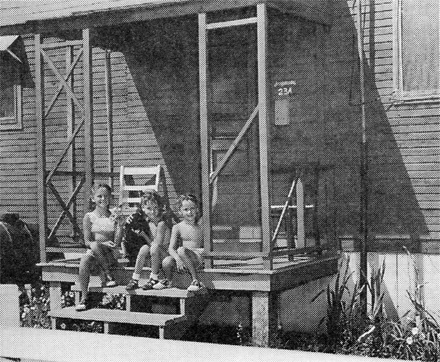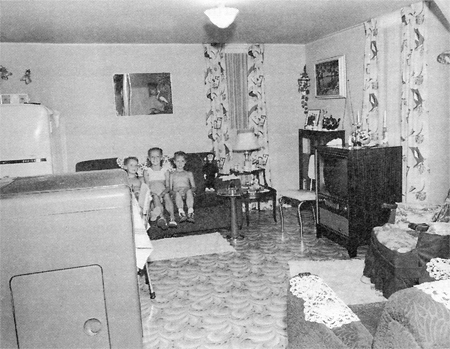
Post-World War II Emergency Housing Project
(written by William Petersen, former Archives Staff)
When veterans returned to La Crosse after World War II, there was a huge housing shortage. By January 1946, the city’s Common Council created the Citizens Emergency Housing Committee to study the problem. It found that 1,300 homes were needed for families in the “ordinary income bracket” and another 300-500 units that were unsuitable for habitation.
As a result, the city asked that the ordnance buildings used by the Sixth Service Command be turned over to the city for emergency housing. During the war, the Civilian Conservation Corps land near Ward Avenue between 22nd Street and Losey Boulevard had been converted in to a maintenance site for vehicles from Camp McCoy. Originally this was the site of Salzer Field, the city’s first municipal airport. This housing effort was called the Ward Avenue Housing Project.

The D. Knothe family on their front porch on Ward Avenue from the book We Need a Roof Over Our Heads: The Story of the La Crosse Housing Authority
The Common Council approved a $45,000 loan to the La Crosse Housing Authority for remodeling of the buildings. Rents were set by the federal Office of Price Administration between $23.42 and $46.42 a month. Local businesses were also contacted for donations to help make the buildings more homelike, and construction workers paid out of their own pocket for asphalt tile flooring for the units to cover up the concrete.
The first eight families moved in on May 4, 1946. Out of the 173 initial applications, these families were considered to have a critical need as they had already had received eviction notices. At the end of the construction period, the La Crosse Tribune noted, “within a month the area will be a little city in itself, with a population of more than 200 and all the services required for the needs of the community.” Good Shepherd Lutheran Church, then a branch of English Lutheran Church, held its first services in one of the barracks in 1954.

The D. Knothe family in their home on the Ward Avenue from the book We Need a Roof Over Our Heads: The Story of the La Crosse Housing Authority
Other emergency housing was set up around the city: Green Bay Street, the Teacher’s College and on the North side on Clinton Street. During the first five years after World War II, the city was able to pursue, with the Federal Housing Administration, other affordable housing that was more permanent included the additions called Salzer Plats which provided 118 homes and Verchota Addition.
The last tenants moved out of the Ward Avenue site in April 1959. The old barracks at the Ward Avenue Housing Project were sold by the Housing Authority to whomever would buy them. By this time, the initial housing shortage had been filled and the La Crosse Housing Authority was able to pursue low cost housing for families and the elderly.
To find more about the history of the La Crosse Housing Authority, read Susan T. Hessel's book We Need a Roof Over Our Heads: The Story of the La Crosse Housing Authority available online.

